

Create Interactive Infographics. New Cinema: How Do You Make An Interactive Narrative? The theme of the New Cinema hackathon was to look at new technology and media and their ability to convey meaning, and in particular to look at how they extend the traditions of cinematic expression.

Here are a few thoughts about designing an interactive narrative for our little hackathon experiment, We Make The Weather. Medium as a Message How do we use technical exploration as a starting point for creating a ‘new cinema’ experience? www.press.umich.edu/pdf/0472111140-03.pdf. Trade and Transport. Humans have been creative in coming up with ways to trade and transport food. © AMNH/D.
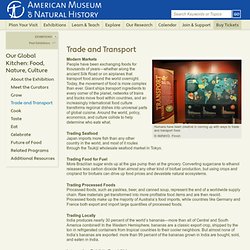
Finnin. Designing Games to Understand Complexity. This is a transcript of a workshop I conducted together with Liam Burke at the Allied Media Conference in June 2013.
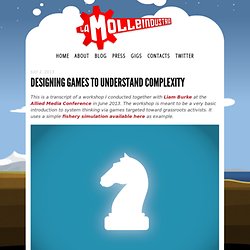
The workshop is meant to be a very basic introduction to system thinking via games targeted toward grassroots activists. It uses a simple fishery simulation available here as example. Games are notoriously hard to define and frame. During this cycle of workshops we are going to approach games from different angles. Water Flow, Food Flow. By Taliesin Nyala 07F To understand how food flows from farms to people Graham Jeffries 06F looked to water.

Jeffries wanted to know how many people could be fed by local food systems in Massachusetts. Visualizing Food Systems. About Joe Mier A native of Danville, Virginia (population 43,055), Joe Mier is currently completing his second and final year of the Research Masters in Media Studies at the University of Amsterdam.
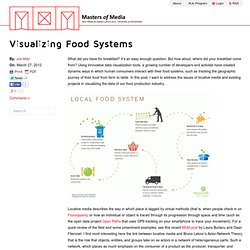
After pursuing a BA in Media Studies at the University of Virginia with a focus in film and television, Joe worked in the field of book and online publishing - first in semantic tagging in Charlottesville, and then in New York at Macmillan Publishers. His current research interests are software studies, convergence and transmedia storytelling, and locative media in urban environments. Changing the Global Food Narrative. Persuasion and the Power of Story. Film synopsis Jennifer Aaker studies happiness, and how stories can affect our happiness; she believes that stories are more meaningful–more memorable, more impactful, and more personal–than statistics alone.
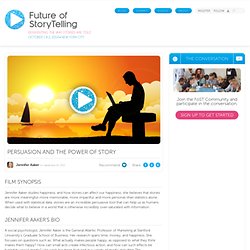
When used with statistical data, stories are an incredible persuasive tool that can help us as humans decide what to believe in a world that is otherwise incredibly over-saturated with information. Jennifer Aaker's bio A social psychologist, Jennifer Aaker is the General Atlantic Professor of Marketing at Stanford University’s Graduate School of Business. foodsecurecanada.org/sites/default/files/Mapping_food_matters.pdf. The world as you've never seen it before. Leader Thoughtship: December 2012. Seth Godin recently wrote about Persuade vs. convince.
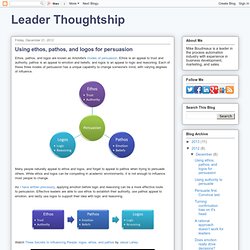
Seth says, "Marketers don't convince. Engineers convince. Marketers persuade. Persuasion appeals to the emotions and to fear and to the imagination. What is the difference between being convinced and persuaded? A person is convinced by evidence or arguments made to the intellect. A person is persuaded by appeals made to the will, moral sense, or emotions. I previously described why the western intellectual tradition is not effective for leaders to drive change. A more compelling way to drive change A more compelling way to get someone to change is offered by Stephen Denning in his book, The Secret Language of Leadership, and in an article by the same name. Excite the lizard brain, persuade the animal brain, and convince the human brain Going back to the Triune Brain Theory, behavior is driven by the lizard and animal brains. Justin Massa on Hacking the Food System: Democratizing Data. [Due to the overwhelming response to our series Hacking the Food System, Food+Tech Connect will be continuing the conversation each Wednesday with a new post from a thought leader in the field.
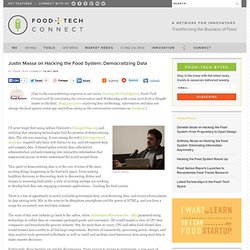
Read past posts exploring how technology, information and data can change the food system status quo and follow along as the conversation continues on Facebook.] Justin Massa This spirit of democratizing data is at the core of some of the most exciting things happening in the food tech space. From making healthier decisions to discovering deals to discovering dishes and recipes to assessing food safety, a slew of exciting startups are working to develop food data into engaging consumer applications – hacking the food system. Communicating science in politicized environments: Arthur Lupia. Arthur Lupia, political science professor at the University of Michigan, kicked off the Science Writing in the Age of Denial conference with a presentation about understanding how people try to avoid conflict with diverse audiences.
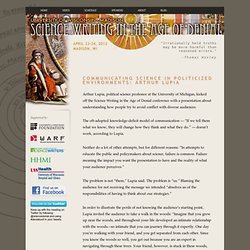
The oft-adopted knowledge-deficit model of communication — “If we tell them what we know, they will change how they think and what they do.” — doesn’t work, according to Lupia. The journey of Communicating Science. Five years ago I fell in love with the concept of virtual water.
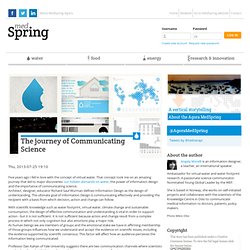
That concept took me on an amazing journey that led to major discoveries: our hidden demands on water, the power of information design and the importance of communicating science. Architect, designer, educator Richard Saul Wurman defines Information Design as the design of understanding. The ultimate goal of Information Design is communicating effectively and providing the recipient with a basis from which decision, action and change can follow. With scientific knowledge such as water footprint, virtual water, climate change and sustainable consumption, the design of effective communication and understanding is vital in order to support action - but it is not sufficient.
It is not sufficient because action and change result from a complex process in which not only cognition but also emotions play a major role. The problem when we become expert in any discipline is that we make assumptions about where our friends are. Understanding Wicked Problems. Horst Rittel, one of the first to research wicked problems, references ten characteristics that describe this sort of complicated societal issue: Clearly, not all problems are wicked; in fact, a problem can be incredibly difficult to solve, but cannot be characterized as wicked until it has an indeterminacy of scope and scale.
The majority of social problems are, by their very nature, wicked. The History of Symbols : Isotype. Otto Neurath Educating via Picture Language A visual program for displaying facts and quantitative information, the ISOTYPE system was born from research and theories of Otto Neurath (1882–1945), a Viennese philosopher, economist and social scientist. As a child he was fascinated by the function of Egyptian hieroglyphics—their forms and ability to communicate a story. This early influence was integrated into his life's work, the development of a system to pictorially organize statistics. Educating for a Sustainable Future: A Transdisciplinary Vision for Concerted Action. A Transdisciplinary Vision for Concerted Action EPD-97/CONF.401/CLD.1.
November 1997. Original: English.